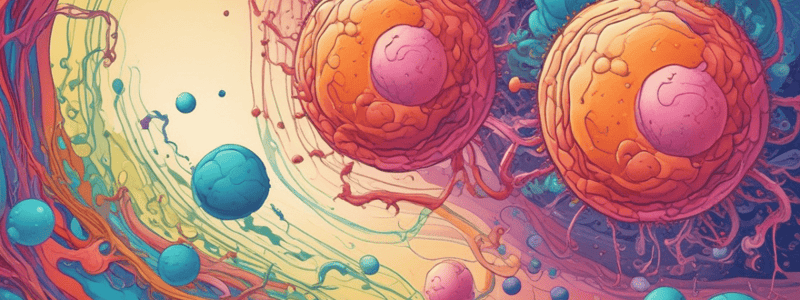Podcast
Questions and Answers
What is the main function of the rough endoplasmic reticulum (RER) in protein synthesis?
What is the main function of the rough endoplasmic reticulum (RER) in protein synthesis?
Synthesizing membrane-bound and secretory proteins.
What occurs to misfolded or improperly assembled proteins in the RER?
What occurs to misfolded or improperly assembled proteins in the RER?
They are recognized and targeted for degradation via the ER-associated degradation (ERAD) pathway.
What is the primary function of the smooth endoplasmic reticulum (SER) in lipid metabolism?
What is the primary function of the smooth endoplasmic reticulum (SER) in lipid metabolism?
Synthesizing lipids, including phospholipids, cholesterol, and steroid hormones.
What is the role of enzymes in the SER in detoxification?
What is the role of enzymes in the SER in detoxification?
What is the function of glucose-6-phosphatase in the SER?
What is the function of glucose-6-phosphatase in the SER?
What is the primary function of the Golgi apparatus in vesicle formation?
What is the primary function of the Golgi apparatus in vesicle formation?
What is the primary function of the SER in muscle contraction?
What is the primary function of the SER in muscle contraction?
What is the primary function of lysosomes in cellular degradation?
What is the primary function of lysosomes in cellular degradation?
What is the primary function of autophagy in cellular maintenance?
What is the primary function of autophagy in cellular maintenance?
What is the function of the cis face of the Golgi complex?
What is the function of the cis face of the Golgi complex?
What type of modifications occur to glycoproteins and glycolipids in the Golgi complex?
What type of modifications occur to glycoproteins and glycolipids in the Golgi complex?
What is the primary site of vesicle formation in the Golgi complex?
What is the primary site of vesicle formation in the Golgi complex?
What is the function of early endosomes in the endocytic pathway?
What is the function of early endosomes in the endocytic pathway?
What is the function of lysosomes in cellular degradation?
What is the function of lysosomes in cellular degradation?
What is the process by which cells recycle membrane receptors and other molecules?
What is the process by which cells recycle membrane receptors and other molecules?
What is the final step in the endocytic pathway, where cellular waste is degraded?
What is the final step in the endocytic pathway, where cellular waste is degraded?
What is the primary function of lysosomes in cellular recycling?
What is the primary function of lysosomes in cellular recycling?
What is the process by which lysosomes digest damaged or unnecessary cellular components?
What is the process by which lysosomes digest damaged or unnecessary cellular components?
What is the term for the transport of materials within the cell via membrane-bound vesicles?
What is the term for the transport of materials within the cell via membrane-bound vesicles?
What is the role of the Golgi apparatus in the vesicular trafficking pathway?
What is the role of the Golgi apparatus in the vesicular trafficking pathway?
What is the term for the process by which cells internalize external substances and particles?
What is the term for the process by which cells internalize external substances and particles?
What is the primary function of vacuoles in plant cells?
What is the primary function of vacuoles in plant cells?
What is the term for the fusion of lysosomes with phagosomes containing pathogens?
What is the term for the fusion of lysosomes with phagosomes containing pathogens?
What is the term for the process by which cells recycle and degrade damaged or unnecessary cellular components?
What is the term for the process by which cells recycle and degrade damaged or unnecessary cellular components?
Flashcards are hidden until you start studying
Study Notes
Lysosomes
- Degrade macromolecules, including proteins, lipids, nucleic acids, and carbohydrates
- Digest damaged or unnecessary cellular components through autophagy, contributing to cellular renewal and homeostasis
- Fuse with phagosomes containing pathogens, leading to their degradation
Vacuoles
- Large membrane-bound compartments filled with cell sap, a solution of water, ions, sugars, amino acids, and other substances
- Store nutrients, waste products, and other substances
- Provide structural support by maintaining turgor pressure, essential for plant cell rigidity
- Sequester harmful substances, detoxifying the cell
Vesicular Trafficking
- Transport of materials within the cell via membrane-bound vesicles
- Form by budding from donor membranes, incorporating specific cargo proteins and lipids
- Transported along the cytoskeleton by motor proteins, such as kinesins and dyneins on microtubules and myosins on actin filaments
- Tethered to and docked at target membranes by tethering proteins and SNARE complexes
- Fuse with the target membrane, releasing its contents into the target compartment
Interrelation of Compartments
- ER-Golgi transport: proteins and lipids synthesized in the ER are transported to the Golgi for further processing and sorting
- Golgi-Endosome-Lysosome Pathway: the Golgi sorts and packages proteins and lipids into vesicles directed to endosomes and lysosomes
- Endosomes mature and deliver their contents to lysosomes for degradation
- Calcium storage: the SER sequesters calcium ions and releases them in response to specific signals, playing a crucial role in muscle contraction and other cellular processes
Golgi Complex
- Consists of a series of flattened membrane-bound sacs called cisternae, organized into stacks
- Has two distinct faces: the cis face (cis-Golgi network, CGN) and the trans face (trans-Golgi network, TGN)
- Medial cisternae lie between the cis and trans faces
- Modifies proteins and lipids, including the addition, removal, or modification of sugar moieties, phosphorylation, and sulfation
- Sorts proteins and lipids and packages them into vesicles for transport to their specific destinations
- The TGN is the primary site where transport vesicles bud off, carrying processed molecules to various cellular destinations
Endosomes
- Formed via endocytosis, mature through stages: early endosomes, late endosomes, and recycling endosomes
- Early endosomes receive endocytosed material and sort it, directing some to recycling endosomes and others to late endosomes for degradation
- Recycling endosomes return membrane receptors and other molecules back to the plasma membrane
- Late endosomes fuse with lysosomes, where their contents are degraded
Lysosomes
- Membrane-bound organelles containing hydrolytic enzymes
- Maintain an acidic pH optimal for enzyme activity
Endomembrane System
- Various compartments, including ER, Golgi, endosomes, and lysosomes, work together to support the coordinated function of the system
Studying That Suits You
Use AI to generate personalized quizzes and flashcards to suit your learning preferences.



